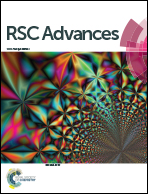Effect of algal species and light intensity on the performance of an air-lift-type microbial carbon capture cell with an algae-assisted cathode†
Abstract
The performances were investigated for air-lift-type microbial carbon capture cells (ALMCCs) with Chlorella vulgaris and Chlorella sp. as cathodic microorganisms. The two ALMCC systems showed differences in CO2 fixation, lipid production and power generation. The ALMCC system with Chlorella vulgaris produced a maximum power density of 558.22 mW m−3, a CO2 fixation rate of 223.68 mg L−1 d−1 and lipid productivity of 21.75 mg L−1 d−1, indicating that Chlorella vulgaris performed better than Chlorella sp. By conducting further experiments with Chlorella vulgaris under different light intensities (2.4, 5.0, 8.9 and 11.4 W m−2), the ALMCC was found to be sensitive to light intensities. The maximum power outputs and CO2 fixation rate were observed under light intensity of 8.9 W m−2 (972.5 mW m−3 and 887.8 mg L−1 d−1, respectively). The lipid productivity was increased with the light intensity from 2.4 to 11.4 W m−2. However, there was no difference in lipid productivities between light intensities of 8.9 and 11.4 W m−2 (p > 0.05). These results suggested that 8.9 W m−2 was the optimal light intensity for CO2 fixation, lipid production and power generation of the ALMCC with Chlorella vulgaris.


 Please wait while we load your content...
Please wait while we load your content...